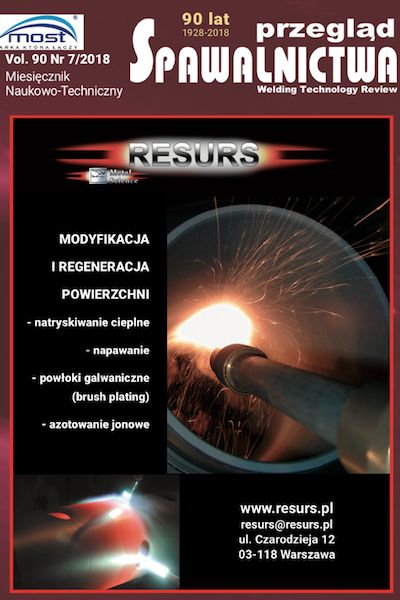Evaluation of high temperature corrosion resistance of hybrid welded membrane walls panels joints of austenitic stainless steel
Main Article Content
Abstract
The growing demands for electricity and UE requirements, regarding the increase in thermal efficiency of power boilers and the reduction of pollution emission to the atmosphere, create a need to modernize the power industry. Raising the parameters of the steam, which increases the thermal efficiency, is one of the ways to meet this requirements. However, achieving a net efficiency of approx. 50% depends on the use of new manufacturing technologies and materials with higher creep resistance than previously used. This article presents the results of high-temperature corrosion resistance test of hybrid welded joints (laser + MAG) of austenitic stainless steel grade 304 used for membrane wall panels. The specimens were placed in an oven in an atmosphere with the composition: N2+9% O2+0.08% SO2 at a temperature of 700 °C and an exposure time of 1000 hours. As a measure of high-temperature corrosion resistance, changes of the mass were adopted. In order to evaluate the oxide layer formed on the surface of the material, the specimens were observed on a scanning electron microscope. The supplement of the research was the chemical (EDS) and phase (XRD) composition analysis. The results confirmed the pres- ence of a layer consisting mainly of Cr2O3 and Fe3O4.
Downloads
Article Details
Creative Commons CC BY 4.0 https://creativecommons.org/licenses/by/4.0/
Welding Technology Review (WTR) articles are published open access under a CC BY licence (Creative Commons Attribution 4.0 International licence). The CC BY licence is the most open licence available and considered the industry 'gold standard' for open access; it is also preferred by many funders. This licence allows readers to copy and redistribute the material in any medium or format, and to alter, transform, or build upon the material, including for commercial use, providing the original author is credited.
References
Hernas A.: Trwałość i niszczenie elementów kotłów i turbin parowych, wyd. Politechniki Śląskiej, Gliwice, 2003.
Formanek B., Szczucka-Lasota B.: Korozja wysokotemperaturowa stali i powłok ochronnych stosowanych w kotłach energetycznych, w: Materiały i technologie stosowane w budowie kotłów nadkrytycznych i spalarni odpadów, wyd. SITPH, Katowice, 2009.
Viswanathan R., Henry J., i inni: Program on Materials Technology for USC Coal Power Plants, ECCC Creep Conf., London, 2005.
Łabanowski J., Głowacka M.: Wysokotemperaturowa trwałość stali i złączy spawanych w środowisku spalin, Przegląd Spawalnictwa 5/2011, s. 2-5
Simms H.G.: Oxidation behavior of austenitic stainless steel at high temperature in supercritical plant, M. Res. thesis, University of Birmingham, 2011.
Turowska A., Adamiec J.: Evaluation of high temperature corrosion resistance of finned tubes made of austenitic steel and nickel alloys, Archives of Metallurgy and Materials, Vol. 61, Iss. 2, 2016, pp. 1089-1093.
Hernas A., Dobrzański J., Pasternak J., Fudali S.: Charakterystyki nowej generacji materiałów dla energetyki, wyd. Politechniki Śląskiej, Gliwice, 2015.
